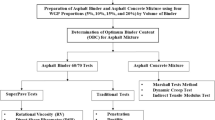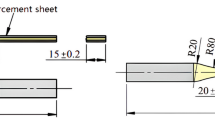Abstract
An asphalt pavement typically has one or more asphalt concrete layers over underlying granular materials. The main purpose of this study is to investigate the effects of debonded pavement structures on fatigue cracking performance using computational analysis program (FlexPAVE™). Both pavement response analysis and pavement performance analysis were conducted to determine the distribution of stresses and strains at the surface and interface of asphalt layers, and to evaluate fatigue cracking performance of debonded pavement structures. A debonded pavement structure can result in much higher tensile stress levels than the fully bonded case, which would consequently lead to the poorer fatigue cracking performance. The FlexPAVE™ simulation results revealed that the debonded surface layers in an asphalt pavement could lead to a reduction of the fatigue performance life of the pavement structure by approximately 90%.
Similar content being viewed by others
References
S.H. Cho, A. Karshenas, A.A. Tayebali, M.N. Guddati, Y.R. Kim, A Mechanistic Approach to Evaluate the Potential of the Debonding Distress in Asphalt Pavements, Inter, J. Pave. Eng. 18 (12) (2017 1098–1110.
S.H. Cho, Evaluation of Interfacial Stress Distribution and Bond Strength between Asphalt Pavement Layers, (Ph.D. dissertation), North Carolina State University, Raleigh, NC., 2016).
J. Uzan, M. Livneh, Y. Eshed, Investigation of Adhesion Properties between Asphaltic Concrete Layers, Asphalt Paving Technol, Proc. 47 (1978) 495–521.
S.F. Brown, J.M. Brunton, The influence of Bonding between Bituminous Layers, Inst, Highw. Transp. 31 (5) (1984) 16–17.
B.A. Al Hakim, An Improved Backcalculation Method to Predict Flexible Pavement Layers Moduli and Bonding Condition between Wearing Course and Base Course, (PhD dissertation), Liverpool John Moores University, Liverpool, U.K., 1997.
E.K. Tschegg, G. Kroyer, D.M. Tan, S.E. Stanzl-Tschegg, J. Litzka, Investigation of Bonding between Asphalt Layers on Road Construction, J, Transp. Eng. 121 (4) (1995) 309–316.
W. Zhang, Effect of Tack Coat Application on Interlayer Shear Strength of Asphalt Pavement: A State-of-the-art Review Based on Application in the United States, Inter, J. Pave. Res. Technol. 10 (5) (2017) 434–445.
L.N. Mohammad, M.A. Elseifi, A. Bae, N. Patel, J. Button, J.A. Scherocman, Optimization of Tack Coat for HMA Placement. Publication NCHRP Report 712. Transportation Research Board of the National Academies, Washington, D.C., 2012.
C. Raab, M. Partl, Interlayer Shear Performance: Experience with Different Pavement Structures, Third Eurasphalt and Eurobitume Congress, Vienna, 2004.
M.R. Kruntcheva, A.C. Collop, N.H. Thom, Effect of Bond Condition on Flexible Pavement Performance, J, Transp. Eng. 131 (11) (2005) 880–888.
J. Lee, H. Ahn, A. Shah, K. Sommer, Investigation of Delamination on I-65 in Indiana, J, Test. Eval. 41 (5) (2013) 1–9.
M. Eslaminia, S. Thirunavukkarasu, M.N. Guddati, Y.R. Kim, Accelerated Pavement Performance Modeling Using Layered Viscoelastic Analysis, Proc. 7th Inter. RILEM Conference on Cracking in Pave., Delft, Netherlands, 2012.
H.J. Park, M. Eslaminia, Y.R. Kim, Mechanistic Evaluation of Cracking in In-Service Asphalt Pavements, Mater, Struct. 47 (8) (2014) 1339–1358.
A. Norouzi, Y.R. Kim, Mechanistic Evaluation of the Fatigue Cracking in Asphalt Pavements, Inter, J. Pave. Eng. 18 (6) (2017) 530–546.
A. Norouzi, D. Kim, Y.R. Kim, Numerical Evaluation of Pavement Design Parameters for the Fatigue Cracking and Rutting Performance of Asphalt Pavements, Mater, Struct. 49 (9) (2016) 3619–3634.
Y. Wang, A. Norouzi, Y.R. Kim, Comparison of Fatigue Cracking Performance of Asphalt Pavements Predicted by Pavement ME and LVECD Programs, Transp, Res. Rec. 2590 (2016) 44–55.
K. Lee, S. Pape, C. Castorena, Y.R. Kim, Evaluation of Small Specimen Geometries for Asphalt Mixture Performance Testing and Pavement Performance Prediction, Transp, Res. Rec. 2631 (1) (2017) 74–82.
K. Lee, C. Castorena, Y.R. Kim, Improving the Reliability of Damage Characteristic Curves in the Simplified Viscoelastic Continuum Damage Model, Transp, Res. Rec. 2672 (28) (2018) 493–502.
M. DeBeer, C. Fisher, L. Kannemeyer, Towards the Application of Stress-In-Motion (SIM) Results in Pavement Design and Infrastructure Protection, Proc. 8th Inter. Sympos. Heavy Vehicles, Weights Dimens., Muldersdrift, Gauteng, South Africa, 2004.
Acknowledgments
This research is sponsored by the North Carolina Department of Transportation under project HWY-2013-04. The authors truly acknowledge the financial support from the North Carolina Department of Transportation. Additional support was provided by University of Kentucky.
Author information
Authors and Affiliations
Corresponding author
Additional information
Peer review under responsibility of Chinese Society of Pavement Engineering.
Rights and permissions
About this article
Cite this article
Cho, S., Lee, K.“., Mahboub, K.C. et al. Evaluation of fatigue cracking performance in a debonded asphalt pavement. Int. J. Pavement Res. Technol. 12, 388–395 (2019). https://doi.org/10.1007/s42947-019-0046-8
Received:
Revised:
Accepted:
Published:
Issue Date:
DOI: https://doi.org/10.1007/s42947-019-0046-8




